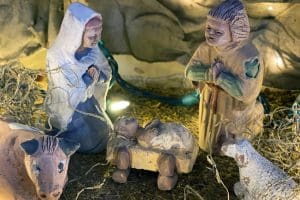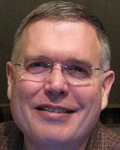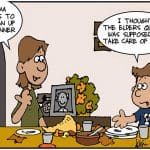![]()
Seattle: A Show Divine at Ninth and Pine!
By Story by Robb Cundick, with photos by Deb Gehris, Marene Foulger and Lee Zurligen.
Seattle, Washington, holds significant memories for me. In 1962 my family came north to visit the World’s Fair. A dance company from Utah was to perform to one of my father’s musical compositions. Dad came to personally act as accompanist and used the trip to the dual benefit of a family vacation. It was here we discovered that President David O. McKay’s office had been trying to reach us all the time we were making our leisurely way up the West Coast. We were asked to immediately return to Salt Lake City for Dad to meet with the President of the Church.

Our vacation cut short, we quickly drove back home having no idea what the meeting was about and speculating all the way. President McKay called Dad to serve a musical mission: playing daily organ recitals at the Hyde Park Chapel in London, England. Within two weeks we had packed our belongings, rented out our house, and boarded a plane for England. A few months after returning from that two-year adventure, Dad was called as a Tabernacle Organist, and thus began our family’s long association with the Choir that continues today with the membership of my brother, Tom, and me.
The Choir arrived in Seattle on the afternoon of Wednesday, June 22, and since our concert wouldn’t be until Thursday evening, we once again had some free time. I had not returned since that abbreviated 1962 vacation and so I wondered if there would be anything I would remember. There was one: the Space Needle, which was the centerpiece of that World’s Fair 43 years ago, but otherwise I didn’t recognize a thing. Many of our group went to a Seattle Mariners baseball game on Wednesday evening (Seattle won in a 12-inning marathon). Thursday morning some of the travelers visited Pike Place Market or took the ferry to Bainbridge Island. My roommate (and brother-in-law), David Jackman, and I decided to join several Choir members for another popular option: “Bill Speidel’s Seattle Underground Tour.”




Early Seattle settlers made the mistake of building their business district on the tidal flats of Puget Sound. Not only was the area perpetually drenched with seawater, it was also at the base of a hill, which brought about the unfortunate consequence that, as residential areas began to proliferate above, the businesses below experienced all kinds of trouble with sewer drainage. Our guide told many amusing stories, but given the unpleasantness of the subject I’ll spare you the details.

When the businesses were destroyed by a fire in 1889, city fathers decided it was a blessing in disguise and a plan was formulated to solve the sewage and seawater problems by raising the whole area between 12 and 36 feet. But much to business owners’ dismay, completion time was estimated at 12 years. The financial burden of such a wait would be too great and so they rebuilt their buildings just as they had been. Meanwhile, the project to elevate the area went ahead with the construction of retaining walls on either side of the streets. Space between the two walls was then filled in and new streets took shape high above the ground floors of the businesses.
The resulting inconvenience and downright hazardous conditions created by the moat-like gulfs between streets and businesses eventually necessitated the erection of steel beams from business to street in order to support an elevated sidewalk at street level. This created enclosed areas bordered by the sidewalks above and below and the business fronts and retaining walls on either side. It is these cavernous areas that have come to be known as the “Seattle Underground.”

Many modern businesses have remodeled and utilized these spaces, but our tour took us to unimproved areas where we could traverse sidewalks built over a century ago and in some cases look at surviving business fronts from the same era. It is interesting to think about how a series of poor decisions could eventually be rectified with a solution that so distinguishes and adds character to a city. I think it’s a wonderful example of how persevering against adversity can turn the tide (in this case, rather literally!) and result in something beneficial. Bill Speidel, by the way, was a colorful and crusty Seattle journalist who helped raise awareness of the need to preserve underground Seattle and who originated the tours in 1965.
We enjoyed our tour, but Thursday afternoon it was time to get back to business! The concert was held at the Paramount Theatre, which originally opened in 1928 as an opulent movie palace. I borrowed its early slogan, “Shows divine at Ninth and Pine!” for the title of this portion of my account because it so aptly describes our performance there. Through the years the theatre has had its ups and downs and has hosted everything from first-run movies to alternative music concerts, but it closed for long periods and finally fell into disrepair. Then, in 1992, Ida Cole – a vice president at Microsoft – took an interest in its preservation and formed a non-profit organization to purchase and renovate it. Over the years, Ida Cole has invested 30 million dollars of her own money towards the purchase, restoration and ongoing support of this beautiful theatre. It has become a top notch facility with state-of-the art sound and lighting and – of “paramount” importance to hosting the Mormon Tabernacle Choir and Orchestra at Temple Square – an expanded stage area!

There is no doubt that it is more satisfying to sing in a theater than an arena – both for the quality of sound and closeness to the audience, which makes it so much easier to connect. As we rehearsed in the afternoon we could tell we were going to love performing in this historic hall. Dr. Jessop seemed concerned about our focus – perhaps due to the number of yawns he observed amongst the group. He cautioned us not to spend so much time sightseeing as to tire and thus diminish our ability to give our very best performance. He reminded us that in the arena of touring classical performers we must have the discipline of a professional. He gave violinist Itzhak Perlman as an example. Mr. Perlman must have performed the Mendelssohn Violin Concerto countless times, and yet each time he must perform it with such freshness that even as it is being played it feels as though it were first emerging from the very pen of Mendelssohn.
Before the rehearsal, Choir Administrative Manager Barry Anderson announced that we would have a guest playing in the orchestra that night. Violist Kate Mitchell is a former member of the Orchestra at Temple Square, now living in the Seattle area. “She asked if I could get her a seat for the concert,” Barry joked, “and the only one I could find for her was in the viola section!”

The Choir first sang in Seattle at the Alaska-Yukon Pacific Exposition in 1909, and has since performed at the 1962 World’s Fair and then again in 1980 and 1986. Of its 1909 performance at the Exposition Amphitheatre (filled to the 15,500 seat capacity), the Seattle Post-Intelligencer said:
“The audience tired itself encoring the numbers. Many musical treats have been offered the people attending the fair and others are to come, but there has not been, so far, any program, vocal or instrumental, that seemed to be received with the same satisfaction as that caused by the Tabernacle Choir.
“.Nothing like it has ever been seen in the history of the city. Distinguished persons have come and gone and had their hearing and been cheered by assembled thousands, but all sank into insignificance in comparison with the spectacle last night.”
What a tough act to follow! Of course – coming 96 years later – we have no idea how the modern-day Choir’s performance may have compared. But we do know that we delighted the 2,869 people – including many prominent Seattle civic, religious, and business leaders – present in the sold-out Paramount Theatre on Thursday night. The Choir and Orchestra were once again in top form and most decidedly rose to Brother Jessop’s challenge to make their performance fresh and vibrant. The audience was exuberant! After “Ah, El Novio No Quere Dinero!,” one man couldn’t restrain himself and shouted, “Bravo!” before the echo of the final chord could even begin to fade.


There was a surprise at the conclusion of the concert. James R. Ellis, a respected civic leader who has played an important role in the redevelopment of downtown Seattle, was invited to lead the Choir in an encore performance of “This Land is Your Land.” Though inexperienced at conducting, Mr. Ellis clearly had a terrific time and the selection held together well. The audience was delighted; they gave him a hearty ovation.

With our hotel only a few blocks away, many of us returned on foot and exchanged greetings with the concertgoers as they walked beside us. It is always a time of smiles and warmth between complete strangers. The language of music and the spirit of our Father in Heaven have broken down the artificial barriers that normally make us hesitant to fully embrace our fellowmen. Seattle has now taken its place among the wonderful memories of the 2005 Mormon Tabernacle Choir and Orchestra at Temple Square Northwestern States Tour.
Next stop: Portland, Oregon!
Seattle PostScript
On Saturday there was an exceedingly favorable review in the Seattle Times. The following is an excerpt:
“That such a large group can sound so musically tight is one of the great wonders of the musical world. Those of us who grew up on this choir’s recordings can attest that hearing it perform live is an irreplaceable experience that ought to be sought out, at least once in a lifetime.”
2005 Meridian Magazine. All Rights Reserved.

















